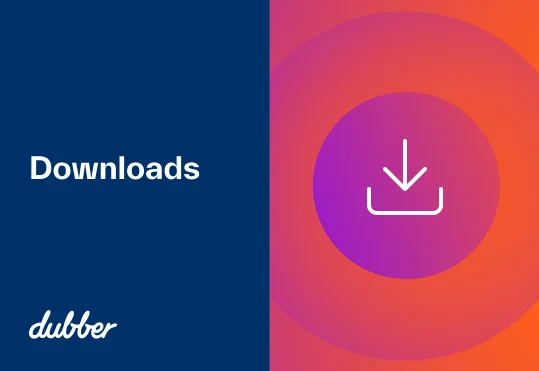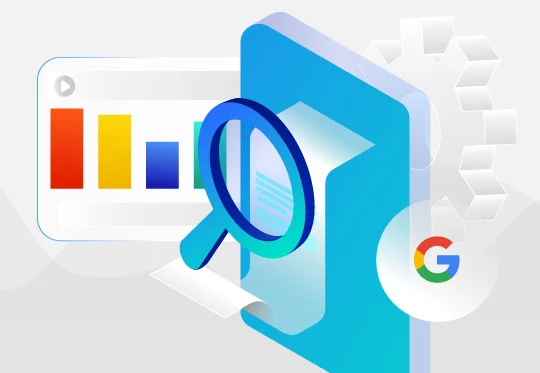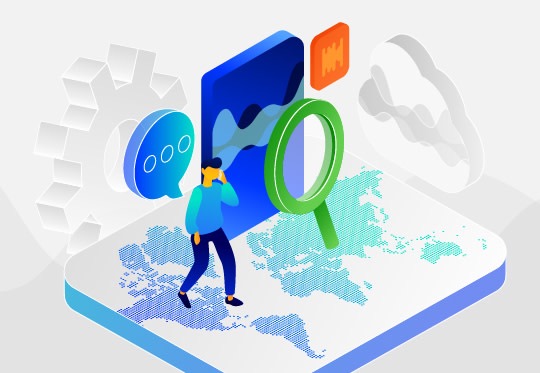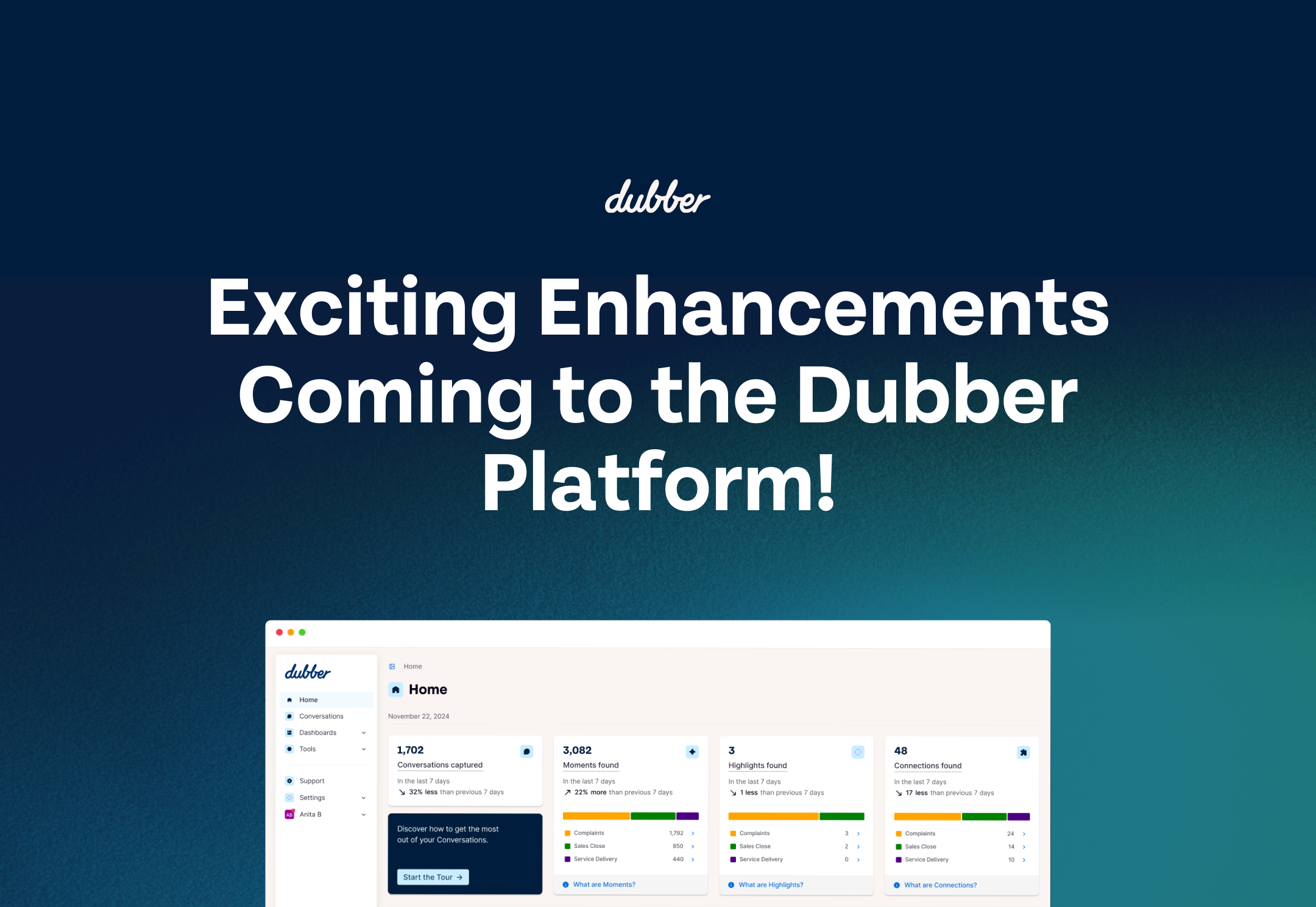
Guest blog written by Mikka Hendra
The current global challenges put a spotlight on IT and IT services – like cloud, Unified Communications, Call Recording, anything and everything surrounding the dramatic movement of staff to home working environments.
While our team is so grateful to be healthy and still able to work, their new challenges have become convincing the kids not to use up the household WiFi downloads for TikTok and Tiger King and remembering they only dressed their upper half for Webex Calls!
Dubber continues to work around the clock to accelerate the global movement to #WorkingFromHome. However despite this global movement, our staff found themselves struggling with basic physical movement besides moving themselves to the fridge and back, while WFH.
The Management team saw an opportunity to optimise the way we worked in these new times and decided to create the Dubber Wellness Hub | Supporting physical distancing, social connection + positive WFH lifestyles.
The Hub was built and rolled out to our workforce as a social health and wellness Hub providing our team with a means for connection, mental health support and resources, general ISO tips, tricks and ideas during physical distancing for COVID-19.
This initiative saw the creation of the Dubber Wellness schedule which includes daily Webex chats by the “office e-water cooler”, online fortnightly health coach wellness coach tips with Jessica Duchesne, UberEats vouchers for a fortnightly team lunch via video, team meditation facilitated by “conscious comedian” Jeremy Carne and after checking on the corporate insurance policy, guided yoga and fitness classes by yours truly.
Along with wellness, we started a weekly themed ‘Bad Fashion Fridays’ competition, dressed in our fashion fails for the day’s video conference meetings. The team look forward to ending the week with some humour at their co-workers expense, before recapping on our Friday Happy Hour chat.
With a new focus on nurturing our teams mental and physical health from a distance, we feel our workforce is becoming closer and more productive than ever and encourage any workplaces still able to work, to rethink how your team connects during this time.

We are pleased to report significant growth for the first half of the 2020 financial year. Highlights include a revenue increase of 125% to $4.5 million, a 79% increase in end user subscribers to 122 549, a contracted annualised recurring revenue of $10.66 million, and 123 service provider agreements, of which 65 are now at the billing stage. During this period we also acquired our first Cisco Webex Calling customers and are on track to be listed on the Cisco price list this month, which will allow seamless order entry within the global Cisco partner channel.
Another highlight was signing an agreement with tier 1 US carrier Sprint Corporation. While we are still in the early stages of growth, securing tier 1 global carriers and our revenue demonstrates that our global strategy is delivering high-quality income streams.
A uniquely placed global operation
We have grown our business operations significantly in preparation for future market opportunities: recruiting team members across executive, sales, and product levels. Many of these new staff members worked closely with us in previous roles with major partners, including Cisco, BroadSoft, AT&T and Telstra, and bring with them significant industry experience. We are a global operation, well positioned to enable service providers to capitalise on the valuable asset of voice data. We believe that transcription, which forms that basis of voice AI and analysis, will become an expected standard feature. We are uniquely placed to deliver this capability to service providers.
Second half FY20 outlook
We expect strong growth in the second half of the 2020 financial year. We expect several verticals to reach the revenue generation stage. Now that our platform is embedded in the Cisco order entry system, we believe this will contribute significantly to our ongoing revenue. Last month we signed an agreement with Telstra, making Dubber available to Telstra customers in Australia. We expect this to underpin similar agreements with new carriers in 2020.

Advances in technology have facilitated a whole host of business developments, increasing efficiency and driving productivity across a variety of industries. But the benefits of such technological improvements are mostly confined to large enterprises who are able to invest in new solutions. Often small businesses face insurmountable barriers to adopting new technology, such as lack of resources, difficulty or reluctance to move away from legacy solutions, and worries about maintaining business continuity.
Future-proofing with the cloud
For service providers and value-added resellers (VARs), the small and medium business (SMB) market can be easy to neglect when faced with obstacles that prevent them from adopting new technology. However, the cloud is providing solutions that can help service providers and VARs to access this market and open up a whole new range of customers. The flexibility and accessibility of cloud solutions break down the obstacles that previously prevented small businesses from adopting new technology. Employees have grown accustomed to using the cloud in everyday life and they now expect to at work, so a move to the cloud is no longer such a daunting prospect.
Resources
Before the advent of the cloud, adopting new technology required not just a financial investment but allocation of other resources including time, trained staff, and physical space. Moving to a new solution meant investing in new hardware and software, along with installation. Deploying new technology often requires a lengthy installation process, along with specially trained staff, ongoing maintenance, and the physical space required to store any hardware such as servers.
Cloud software as a service (SaaS) solutions break down these barriers, allowing service providers and VARs to offer products and services on tailored monthly subscription plans that require no upfront investment from SMBs. Even traditional software companies like Microsoft now offer packages such as their Office product suite as SaaS. Where customers would once have bought a CD to install each new version on their computer, cloud versions can apply updates automatically and are transferable between devices. Cloud solutions require no hardware, meaning no need for specially trained staff, maintenance or storage space. Businesses can also start using the services immediately with no delays created by installation processes.
Legacy solutions
Although small businesses are known for their agility, when it comes to adopting new technology they may be unwilling to move to a different service if they have previously invested heavily in a legacy solution. Service providers and VARs could offer a compromise with a solution that enhances what they already have, without requiring a complete overhaul.
Business continuity
There are often worries about business continuity when considering adopting new technology. Cloud solutions often facilitate a smooth transition, with much shorter implementation periods and open APIs allowing integration with existing systems.
Dubber and the cloud
Dubber call recording and voice AI are great examples of how the cloud can help small businesses adopt new technology. Our services are all available on a monthly subscription, with no upfront investment, hardware, or trained staff required. We connect directly to the network to capture voice data, so businesses do not need to install any equipment on premise or worry about maintenance or storage space. We understand that businesses may not want to part with expensive legacy equipment and so we also work with businesses who want to keep their on-premise solutions, extracting the voice data for transcription and analytics. Our open API allows companies to integrate call data into their existing systems, ensuring business processes continue to run smoothly.

How well do you listen to your customers? Turns out, they could be telling you more than you think. Dubber AI has the potential to tell you exactly what your customers think about your brand and products, and even guide you to deliver what they want.
Every conversation with a customer is packed with vital information: a mention of a competitor’s name can be a prompt for the retention team, angry words can indicate product or customer service issues and might lose you repeat business, but a phone call full of kind words and thanks can show you that a member of your contact centre team deserves a reward.
Stand out from the competition
Customer service is the top differentiator between brands and the more you know about your customer, the more you can understand how to improve their experience. With Dubber AI, customer calls are transcribed using speech to text engines. These transcriptions can be stored against the customer within a CRM, when integrated with our API. This valuable data opens up huge potential to learn more about your customers. Customer service teams would have access to information from previous calls at their fingertips, allowing them to help with enquiries more quickly and easily.
Personalisation is becoming part of customer expectations as services such as Netflix offer tailored recommendations to users and Spotify creates playlists based on user listening behaviour. In the past it might have been difficult for other businesses to offer such a personalised approach due to limited data but, with the introduction of voice AI, that’s no longer the case. With call transcripts integrated into CRM systems, this allows businesses to create detailed customer profiles, enabling them to provide hyper-personalised customer interactions. This means a customer can call a large customer service centre and be directed to the agent that they have spoken to previously.
Proactive customer service
AI helps in the day-to-day running of a customer service team. Information from sentiment analysis can help managers understand trends about complaints, and train their staff to deal with common issues more efficiently. The possibilities for the future of AI are limitless: from automatic call routing to the best agent based on historical call transcripts, to proactive calming measures for customers who have consistent negative sentiment in their previous interactions.
Accessibility
Dubber AI doesn’t require in-house data scientists or machine learning experts. With our platform directly connected to carriers, introducing AI to a business has never been easier.
To find out more about how Dubber AI can improve customer service, talk to a member of our team today.

Telstra and Dubber Sign Agreement for cloud call recording and AI on Business Telephony and mobile services

Can you tell the difference between an Australian saying ‘a boat’, an American saying ‘a bat’, someone from the UK saying ‘a boot’ and a Canadian saying ‘about’? Google can.
Here at Dubber, we have a team dedicated to expanding our AI capabilities. We know that in today’s global economy, where businesses operate from locations around the world, English speakers don’t all speak like the Queen of England (no matter how many episodes of The Crown we watch). We want to ensure that our voice AI can support businesses in their global operations, with transcription that covers not just variants of English but other languages spoken by millions around the world.
That’s why we added Google’s Speech-to-Text machine learning product to our suite of transcription engines, so that we can deliver the best transcription capabilities across the broadest set of languages and accents.
Transcription with unparalleled accuracy
Adding Google’s transcription means we can now support a wider range of languages, including Dutch, French, Spanish, German, Mandarin, Portuguese, and six regional variants of English. This will allow us to serve more of the world with our cloud call recording and voice AI. Google Speech-to-Text applies powerful neural network models to transcribe audio from a variety of sources with high levels of accuracy. These deep-learning algorithms are under constant improvement, with ever-increasing accuracy.
Google Speech-to-Text is now available on Dubber as a premium AI engine. Want to learn more about how you can access the benefits of transcription powered by Google? Talk to our team today.

In a world that is increasingly reliant on a workforce that can work anytime, anywhere, businesses are looking for increased connectivity through innovations in wired and wireless solutions. Enter fixed-mobile convergence (FMC), where calls can be seamlessly transferred from fixed to mobile devices and vice versa. Read an in-depth guide to FMC in our white paper.
Although FMC is by no means new, the infrastructure and investment required means it has been slow to realise. But with advancing technology, the idea of combining offerings into one bundle for customers is beginning to gain traction. Could 2020 see developments in converged offerings?
What does FMC mean for businesses?
The growing popularity of FMC is the result of both customer needs and networks looking to stay ahead of the competition and retain customers with more powerful, personalised services.
FMC solutions create a union between wired and wireless technologies and allow calls to continue without dropping even as the user moves from location to location and between devices. FMC also enables better reachability, so that customer-facing employees can be reached on the first try — whether they are in the office or out on the road. Similarly, single-number reach allows customers and clients to contact a business on one number that redirects calls to available contacts, through cloud-based communications technology.
Enterprises that deploy solutions that unify fixed and mobile communications will see increased productivity.
What does FMC mean for telecommunications service providers?
Telecommunications service providers have already begun to buy into the concept and are benefitting from being early adopters of the technology. By bundling their fixed and mobile services, service providers are likely to reduce customer churn as they are able to offer cheaper packages, while increasing average revenue per user.
These simplified communication solutions also make it easy for providers to offer value-added services like cloud-based call recording from one single, unified portal without requiring any up-front investment, hardware or lengthy setup processes.
By moving to the cloud, telecommunications service providers can combine wired and wireless communications in one solution, offering greater flexibility, ease of use, and reduced IT and network costs for providers and their users.
Get in touch to find out more about how Dubber call recording and voice AI can work with FMC solutions.

The fifth, and final, instalment of our Fourth Industrial Revolution series explores what telecommunication service providers need to do in order to provide for the new digital workforce. Part one of the series gave an overview of the Fourth Industrial Revolution, part two looked at intuitive networks and how 5G and cloud technology fit into developments in the telecommunications industry, part three examined the growing importance of diversity in telecommunications product offerings, and part four examined the evolving expectations of customers.
The digital workforce is a manifestation of automated solutions, in various stages of development, that are currently driving productivity in the workforce. Integrations that share data across business tools are making workers and business processes more efficient, allowing employees to focus on more valuable activities. Over the next few years, enterprises will be increasingly deploying efficiency solutions driven by automation in order to improve the quality and productivity of their operational, back office, and customer service processes. Telecommunication service providers need to ensure they are meeting the expectations of modern businesses with their offerings, or they may be faced with increased risk of customer churn.
The connected workforce
Connectivity is steadily increasing due to innovation within the telecommunications industry, such as fixed-mobile convergence (FMC). You can read more about FMC in our white paper. However, digital players are making their way into the marketplace and disrupting the industry with rapid digital innovation. These agile disruptors are unpredictable and aren’t restricted by the legacy infrastructure and long development cycles that can hold traditional telecommunication service providers back from innovation. Digital services can often offer more opportunities for integration with existing systems, as well as better connectivity. Telecommunications service providers will need to innovate to compete with these digital players.
Alternative innovation
Innovation in the telecommunication industry has traditionally been characterised by staged developments that span multiple years. In order to compete with digital players and develop new products and services that can be deployed at scale, providers will need to review their innovation strategies. The World Economic Forum has discussed a recent trend towards innovation approaches that focus on collaboration, and the positive impact on growth that this achieves. Gone are the days of focusing on the ownership rights to intellectual property: the main focus in the future should be putting customers first. This is vital to obtaining a share of the market. These kinds of open innovation models allow external parties to contribute to the development of products and services, often achieving development at a scale that goes beyond the sum of its parts. Telecommunications companies have successfully nurtured a “sandbox” innovation approach that allows their research and development teams to work autonomously: giving them greater freedom for innovation.
Harnessing data
Data is increasingly being used to solve business problems and increase productivity within organisations. According to a 2019 report1, data science expertise is now a highly sought-after skill. Telecommunications service providers have a key role to fill in harnessing the vast amounts of conversational data held within our communications. With access to this valuable information, data scientists will be able to analyse and identify data trends, as well as problems that can be solved, through artificial intelligence.
Our Fourth Industrial Revolution series has shown that the telecommunications industry has a key role to play in shaping the way we communicate, collaborate, and consume. With developments in networks and product offerings, service providers can capitalise on the evolving expectations of customers and stay ahead of the competition. New methods of innovation can help them to compete with digital players, and their customer bases can provide them with the data they need to provide personalised offerings that will reduce churn and help with customer acquisition.
1Firebrand, Vitamin T & Aquent (2019) Transformation of the Digital Workforce: 2019 Report. Australia.

Our cloud call recording is now available for immediate signup for all customers on the Sprint® Smart UC service. With 53.9 million connections, that’s a huge number of users who can start to reap the benefits of recording their calls in the cloud.
The cloud-based unified communications (UC) service eliminates the need for traditional on-premise equipment and capital expenditure for business customers and so is a natural fit for our software as a service (SaaS) products. Their affordable unified communications as a service (UCaaS) solution allows users to combine their business phones and collaboration apps in one UC service. The solution helps to improve productivity by amalgamating carrier grade voice services with high definition video, desktop sharing, instant messaging and email.
Just as our cloud call recording is designed with small businesses in mind, Sprint® Smart also offers a service that is perfect for small and medium enterprises. As a cloud service, the need for upfront investment in on-premise hardware provides flexibility for businesses. Users can be added and removed on a monthly basis, through an easy-to-use online portal, and our call recording services can be added and adjusted in the same way.
Dubber call recording, as standard
With our cloud call recording available as a standard value-added business feature for all Smart UC customers, our CEO Steve McGovern commented: ‘We are very proud to be working with Sprint, a globally recognised leader in the telecommunications industry.” You can read more from Steve in the full ASX announcement below.
To find out how to add value to your business with call recording, speak to a member of our team today.

Dubber Call Recording Capability Available on Sprint Smart UC Platform

